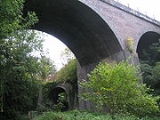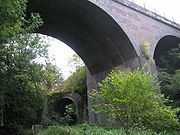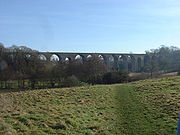
Bristol and North Somerset Railway
Encyclopedia
The Bristol and North Somerset Railway was a railway line in the West of England
that connected Bristol
with towns in the Somerset coalfield
. The line ran almost due south from Bristol and was 16 miles long.
, where it joined with an earlier freight only line from Frome
to Radstock that had been built in 1854 as part of the Wilts, Somerset and Weymouth Railway
. Through services between Bristol and Frome began two years later, in 1875, at which point the line was formally taken into ownership by the Great Western Railway
, which had absorbed the WS&WR in 1850.
 In 1882, a branch line from Hallatrow was built to Camerton
In 1882, a branch line from Hallatrow was built to Camerton
; in 1910, this line was further extended eastwards along the route of the former Somerset Coal Canal
to join up with the line from Bath
to Bradford-on-Avon railway station line at Limpley Stoke
.
The Camerton branch was mainly used for coal - in particular, the colliery at Camerton. The original line from Hallatrow to Camerton closed in 1932, with Camerton becoming the western terminus - having also been the eastern terminus and a through station.(Another example of this is Uckfield, Sussex). .
Traffic on the Camerton line from Hallatrow to Limpley Stoke was even lighter: passenger services started in 1910 and were suspended for the First World War in 1915; they resumed in 1923 (though Midford Halt never reopened) but were withdrawn entirely in 1925. Freight services on the branch line ceased in 1951. The line achieved some fame after closure by its use in the film The Titfield Thunderbolt
, but the track was taken up in 1958.
The Bristol and North Somerset main line did not last much longer. From the point where the line turned northwards towards Bristol, only three miles out of Radstock, it ran virtually parallel to the main A37 road
, which made it vulnerable to competition from road transport. Passenger services were withdrawn in November 1959 and freight traffic ended in July 1968, when the Radstock to Bristol section closed completely. The Radstock to Frome portion remained in occasional use until July 1988 for traffic to the Marcroft wagon works on the outskirts of Radstock, and part of this section remains in situ today (although derelict and heavily overgrown). The southernmost section from Frome to Hapsford Quarry Junction remains in use for limestone traffic from Whatley Quarry
 The original stations were in most cases built to a standard but distinctive design by the architect William Clarke, featuring large canopies and three tall chimneys. Clarke designed stations on other "minor" Great Western satellite railways.
The original stations were in most cases built to a standard but distinctive design by the architect William Clarke, featuring large canopies and three tall chimneys. Clarke designed stations on other "minor" Great Western satellite railways.
The B&NSR was one of the railways carried on the Midford
viaduct
s (see photograph above). This was an unusual 'bridge over a bridge' construction where the B&NSR traversed a river valley on a viaduct which passed under the Somerset and Dorset Joint Railway
which crossed the same valley on an almost perpendicular course on a taller viaduct.
The biggest civil engineering project on the line was the Pensford
Viaduct over the River Chew
. The viaduct is 995 feet long, reaches a maximum height of 95 feet to rail level and consists of sixteen arches and is now a Grade II listed structure.
.
England
England is a country that is part of the United Kingdom. It shares land borders with Scotland to the north and Wales to the west; the Irish Sea is to the north west, the Celtic Sea to the south west, with the North Sea to the east and the English Channel to the south separating it from continental...
that connected Bristol
Bristol
Bristol is a city, unitary authority area and ceremonial county in South West England, with an estimated population of 433,100 for the unitary authority in 2009, and a surrounding Larger Urban Zone with an estimated 1,070,000 residents in 2007...
with towns in the Somerset coalfield
Somerset coalfield
The Somerset Coalfield included pits in the North Somerset, England, area where coal was mined from the 15th century until 1973.It is part of a wider coalfield which covered northern Somerset and southern Gloucestershire. It stretched from Cromhall in the north to the Mendip Hills in the south, and...
. The line ran almost due south from Bristol and was 16 miles long.
The main railway
The line was opened in 1873 between Bristol and RadstockRadstock
Radstock is a town in Somerset, England, south west of Bath, and north west of Frome. It is within the unitary authority of Bath and North East Somerset and had a population of 5,275 according to the 2001 Census...
, where it joined with an earlier freight only line from Frome
Frome railway station
Frome railway station serves a largely rural area of the county of Somerset in England, and is situated in the town of Frome.The station is located on a long branch line which loops off the main line railway, which carries services on both the Reading to Taunton line and Bristol to Weymouth route...
to Radstock that had been built in 1854 as part of the Wilts, Somerset and Weymouth Railway
Wilts, Somerset and Weymouth Railway
The Wilts, Somerset and Weymouth Railway was a broad gauge railway that linked the Great Western Railway at Chippenham in 'Wilts' with Weymouth in Dorset, England. Branches ran to Devizes, Bradford-on-Avon and Salisbury in Wiltshire, and to Radstock in Somerset. The majority of the line survives...
. Through services between Bristol and Frome began two years later, in 1875, at which point the line was formally taken into ownership by the Great Western Railway
Great Western Railway
The Great Western Railway was a British railway company that linked London with the south-west and west of England and most of Wales. It was founded in 1833, received its enabling Act of Parliament in 1835 and ran its first trains in 1838...
, which had absorbed the WS&WR in 1850.
The Camerton branch

Camerton, Somerset
Camerton is a village and civil parish in Somerset, south west of Bath, lying on the Cam Brook. The parish has a population of 660.-History:...
; in 1910, this line was further extended eastwards along the route of the former Somerset Coal Canal
Somerset Coal Canal
The Somerset Coal Canal was a narrow canal in England, built around 1800 from basins at Paulton and Timsbury via Camerton, an aqueduct at Dunkerton, Combe Hay, Midford and Monkton Combe to Limpley Stoke where it joined the Kennet and Avon Canal...
to join up with the line from Bath
Bath Spa railway station
Bath Spa railway station is the principal railway station in the city of Bath, in South West England.-Architecture:Bath Spa station was built in 1840 for the Great Western Railway by Brunel and is a grade II* listed building...
to Bradford-on-Avon railway station line at Limpley Stoke
Limpley Stoke
Limpley Stoke is a village and civil parish in Wiltshire, in the Avon Valley, between Bath and Freshford. The village is below the A36 road.The civil parish, which had a population of 637 in 2001, also includes the hamlet of Waterhouse, and the outskirts of the Somerset village of Midford. The 18th...
.
The Camerton branch was mainly used for coal - in particular, the colliery at Camerton. The original line from Hallatrow to Camerton closed in 1932, with Camerton becoming the western terminus - having also been the eastern terminus and a through station.(Another example of this is Uckfield, Sussex). .
Line traffic
The principal traffic on the railway was coal from the Somerset coalfield, though the villages nearer Bristol generated some commuter traffic. Passenger services were never frequent: in 1910, there were eight trains a day at most (on Thursdays and Saturdays) and not all of those ran through to or from Frome.Traffic on the Camerton line from Hallatrow to Limpley Stoke was even lighter: passenger services started in 1910 and were suspended for the First World War in 1915; they resumed in 1923 (though Midford Halt never reopened) but were withdrawn entirely in 1925. Freight services on the branch line ceased in 1951. The line achieved some fame after closure by its use in the film The Titfield Thunderbolt
The Titfield Thunderbolt
The Titfield Thunderbolt is a 1953 British comedy film about a group of villagers trying to prevent British Railways from closing the fictional Titfield branch line. The film was written by T.E.B...
, but the track was taken up in 1958.
The Bristol and North Somerset main line did not last much longer. From the point where the line turned northwards towards Bristol, only three miles out of Radstock, it ran virtually parallel to the main A37 road
A37 road
The A37 is a major road in southern England. It runs north from the A35 at Dorchester in Dorset into Somerset through Yeovil and Shepton Mallet before terminating at the Three Lamps junction with the A4 in central Bristol...
, which made it vulnerable to competition from road transport. Passenger services were withdrawn in November 1959 and freight traffic ended in July 1968, when the Radstock to Bristol section closed completely. The Radstock to Frome portion remained in occasional use until July 1988 for traffic to the Marcroft wagon works on the outskirts of Radstock, and part of this section remains in situ today (although derelict and heavily overgrown). The southernmost section from Frome to Hapsford Quarry Junction remains in use for limestone traffic from Whatley Quarry
Whatley Quarry
Whatley Quarry, is a limestone quarry owned by Hanson plc, near the village of Whatley on the Mendip Hills, Somerset, England.The quarry exhibits pale to dark grey Carboniferous Limestone with small area of overlying horizontally bedded buff-coloured Jurassic oolitic limestone forming an angular...
Features

The B&NSR was one of the railways carried on the Midford
Midford
Midford is a village approximately miles south south east of Bath, Somerset, England within the Cotswold Area of Outstanding Natural Beauty...
viaduct
Viaduct
A viaduct is a bridge composed of several small spans. The term viaduct is derived from the Latin via for road and ducere to lead something. However, the Ancient Romans did not use that term per se; it is a modern derivation from an analogy with aqueduct. Like the Roman aqueducts, many early...
s (see photograph above). This was an unusual 'bridge over a bridge' construction where the B&NSR traversed a river valley on a viaduct which passed under the Somerset and Dorset Joint Railway
Somerset and Dorset Joint Railway
The Somerset & Dorset Joint Railway – almost always referred to as "the S&D" – was an English railway line connecting Bath in north east Somerset and Bournemouth now in south east Dorset but then in Hampshire...
which crossed the same valley on an almost perpendicular course on a taller viaduct.
The biggest civil engineering project on the line was the Pensford
Pensford
Pensford is a village in the civil parish of Publow and Pensford in Somerset, England. It lies in the Chew Valley south of Bristol and west of Bath...
Viaduct over the River Chew
River Chew
The River Chew is a small river in England. It merges with the River Avon after forming the Chew Valley.The spring from which the Chew rises is just upstream from Chewton Mendip. The river flows North West from Chewton Mendip through Litton, Chew Valley Lake, Chew Stoke, Chew Magna and Stanton Drew...
. The viaduct is 995 feet long, reaches a maximum height of 95 feet to rail level and consists of sixteen arches and is now a Grade II listed structure.
Preservation
The plan at Clutton was to rebuild the 1873 William Clarke station, signal box, shelter and environs and to have a mile and a half steam railway on the Bristol and North Somerset mainline up to King Lane summit and down the 1 in 60 to Chelwood Roundabout park and ride for embarking passengers. Passengers would change at Clutton, look round the restored station, museum, shop and buffet car in the lower yard goods dock then change from pannier and 2 mark 1's in the old upper level passenger station, to an industrial 0-6-0 tank and brake vans at a new non-original halt on the lower goods yard, for a ride up the parallel mile long Fry's Bottom branch which diverged on the split level retaining wall at King Lane, off into Fry's Bottom Colliery where a deep pit mining museum was planned using the last 500 foot open shaft in the Somerset coalfield. This railway could have eventually extended south back to Hallatrow station and north under the intact Chelwood bridge + roundabout overfill, to Pensford and Bromley Colliery sidings halt. The project ran from July 2004 to December 2007 when it folded due to council property board and highways problems..

